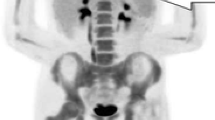Abstract
Granulocyte colony-stimulating factor (G-CSF) analogs such as filgrastim/pegfilgrastim are increasingly used to enhance neutrophilic recovery after chemotherapy. It is widely known that, physiologically, pegfilgrastim stimulates marrow mitotic activity and induces marrow reconversion from fatty to cellular. However, there is limited literature discussing the effects of pegfilgrastim on musculoskeletal magnetic resonance imaging, with the consensus that marrow reconversion secondary to pegfilgrastim therapy is easily confounded with a malignant process, especially in patients with a history of cancer. We attempt to discuss the expected changes and MRI findings after pegfilgrastim therapy through a summary of current literature. Additionally, we provide images from our own practice to support the previously established findings. G-CSF-stimulated reconversion can appear as patchy expansions of baseline hematopoietic marrow, but can also appear to be diffusely homogeneous, adding to its ambiguity. We conclude that using a baseline MRI, clinical information, and assessing sequential MRI changes in conjunction with pegfilgrastim therapy may aid the differentiation between benign and pathological change. We expand our discussion to include the effects of novel technologies, such as whole-body MRI, chemical shift imaging, and contrast agents in helping the distinction.







Similar content being viewed by others
References
Farese AM, Yang BB, Roskos L, Stead RB, MacVittie TJ. Pegfilgrastim, a sustained-duration form of filgrastim, significantly improves neutrophil recovery after autologous marrow transplantation in rhesus macaques. Bone Marrow Transplant. 2003;32(4):399–404. Available from: http://www.nature.com/articles/1704156
Tegg EM, Tuck DM, Lowenthal RM, Marsden KA. The effect of G-CSF on the composition of human bone marrow. Clin Lab Haematol. 1999;21(4):265–70. https://doi.org/10.1046/j.1365-2257.1999.00227.x.
Curran MP, Goa KL. Pegfilgrastim. Drugs. 2002;62(8):1207–13. Available from: http://www.ncbi.nlm.nih.gov/pubmed/12010086
Proteins T, Drugs GI. Book review: biotechnology and biopharmaceuticals: transforming proteins and genes into drugs. Q Rev Biol. 2003;78(4):516. https://doi.org/10.1086/382470.
Inc. A. Neulasta (pegfilgrastim) injection prescribing information. Thousand Oaks; 2002.
Holmes F, O’Shaughnessy J, Vukelja S. Blinded, randomized, multicenter study to evaluate single administration pegfilgrastim once per cycle versus daily filgrastim as an adjunct to chemotherapy in breast cancer. J Clin Oncol. 2002;20(3):727–31. https://doi.org/10.1200/JCO.2002.20.3.727.
Barnes G, Pathak A, Schwartzberg L. G-CSF utilization rate and prescribing patterns in United States: associations between physician and patient factors and GCSF use. Cancer Med. 2014;3(6):1477–84. https://doi.org/10.1002/cam4.344.
Farese AM, Macvittie TJ. Filgrastim for the treatment of hematopoietic acute radiation syndrome. Drugs of Today. 2015;51(9):537–48. Available from: http://www.ncbi.nlm.nih.gov/pubmed/26488033
Lambertini M, Del Mastro L, Bellodi A, Pronzato P. The five “Ws” for bone pain due to the administration of granulocyte-colony stimulating factors (G-CSFs). Crit Rev Oncol Hematol. 2014;89(1):112–28.
Yang BB, Kido A. Pharmacokinetics and pharmacodynamics of pegfilgrastim. Clin Pharmacokinet. 2011;50(5):295–306. https://doi.org/10.2165/11586040-000000000-00000.
Mulcahy N. FDA Approves Pegfilgrastim Biosimilar for Cancer Infection Risk [Internet]. Medscape. 2018 [cited 2018 Jul 14]. Available from: https://www.medscape.com/viewarticle/897614
Ricci C, Cova M, Kang YS, Yang A, Rahmouni A, Scott WW, et al. Normal age-related patterns of cellular and fatty bone marrow distribution in the axial skeleton: MR imaging study. Radiology. 1990 Oct;177(1):83–8. https://doi.org/10.1148/radiology.177.1.2399343.
McGee SJ, Havens AM, Shiozawa Y, Jung Y, Taichman RS. Effects of erythropoietin on the bone microenvironment. Growth Factors. 2012;30(1):22–8. Available from: http://www.ncbi.nlm.nih.gov/pubmed/22117584
Ghanem N, Lerche A, Lohrmann C, Altehoefer C, Henke M, Langer M. Quantitative and semiquantitative evaluation of erythropoietin-induced bone marrow signal changes in lumbar spine MRI in patients with tumor anemia. Onkologie. 2007;30(6):303–8. Available from: http://www.ncbi.nlm.nih.gov/pubmed/17551253
Naples JC, Taljanovic MS, Graham ML, Hunter TB. Granulocyte-stimulating factor-induced bone marrow reconversion simulating neuroblastoma metastases on MRI: case report and literature review. Radiol Case Rep. 2007;2(1):5–9. Available from: http://www.ncbi.nlm.nih.gov/pubmed/27303451
Smith SR, Williams CE, Davies JM, Edwards RH. Bone marrow disorders: characterization with quantitative MR imaging. Radiology. 1989;172(3):805–10. https://doi.org/10.1148/radiology.172.3.2772192.
Ollivier L, Gerber S, Vanel D, Brisse H, Leclère J. Improving the interpretation of bone marrow imaging in cancer patients. Cancer Imaging. 2006;6(1):194–8. Available from: https://www.ncbi.nlm.nih.gov/pmc/articles/PMC1766564/
Hartman RP, Sundaram M, Okuno SH, Sim FH. Effect of granulocyte-stimulating factors on marrow of adult patients with musculoskeletal malignancies: incidence and MRI findings. AJR Am J Roentgenol. 2004;183(3):645–53. https://doi.org/10.2214/ajr.183.3.1830645.
Fletcher BD, Wall JE, Hanna SL. Effect of hematopoietic growth factors on MR images of bone marrow in children undergoing chemotherapy. Radiology. 1993;189(3):745–51. Available from: http://www.ncbi.nlm.nih.gov/pubmed/7694312
Layer G, Sander W, Träber F, Block W, Ko Y, Ziske CG, et al. The diagnostic problems in magnetic resonance tomography of the bone marrow in patients with malignomas under G-CSF therapy. Radiologe. 2000;40(8):710–5. Available from: http://www.ncbi.nlm.nih.gov/pubmed/11006941
Vanel D, Missenard G, Le Cesne A, Guinebretière JM. Red marrow recolonization induced by growth factors mimicking an increase in tumor volume during preoperative chemotherapy: MR study. J Comput Assist Tomogr. 1997;21(4):529–31. Available from: http://www.ncbi.nlm.nih.gov/pubmed/9216756
Kouba M, Maaloufova J, Campr V, Belohlavek O, Drugova B. G-CSF stimulated islands of haematopoiesis mimicking disseminated malignancy on PET-CT and MRI scans in a patient with hypoplastic marrow disorder. Br J Haematol. 2005;130(6):807. https://doi.org/10.1111/j.1365-2141.2005.05574.x.
Douis H, Davies AM, Jeys L, Sian P. Chemical shift MRI can aid in the diagnosis of indeterminate skeletal lesions of the spine. Eur Radiol. 2016;26(4):932–40. Available from: http://www.ncbi.nlm.nih.gov/pubmed/26162578
Ghanem N, Altehoefer C, Kelly T, Lohrmann C, Winterer J, Schäfer O, et al. Whole-body MRI in comparison to skeletal scintigraphy in detection of skeletal metastases in patients with solid tumors. In Vivo. 2006;20(1):173–82. Available from: http://www.ncbi.nlm.nih.gov/pubmed/16433049
Ballon D, Watts R, Dyke JP, Lis E, Morris MJ, Scher HI, et al. Imaging therapeutic response in human bone marrow using rapid whole-body MRI. Magn Reson Med. 2004;52(6):1234–8. Available from: http://www.ncbi.nlm.nih.gov/pubmed/15562475
Baur A, Stäbler A, Bartl R, Lamerz R, Scheidler J, Reiser M. MRI gadolinium enhancement of bone marrow: age-related changes in normals and in diffuse neoplastic infiltration. Skelet Radiol. 1997;26(7):414–8. Available from: http://www.ncbi.nlm.nih.gov/pubmed/9259099
Daldrup-Link HE, Henning T, Link TM. MR imaging of therapy-induced changes of bone marrow. Eur Radiol. 2007;17(3):743–61. https://doi.org/10.1007/s00330-006-0404-1.
Wood AJJ, Lieschke GJ, Burgess AW. Granulocyte colony-stimulating factor and granulocyte-macrophage colony-stimulating factor. N Engl J Med. 1992;327(1):28–35. https://doi.org/10.1056/NEJM199207023270106.
Author information
Authors and Affiliations
Corresponding author
Ethics declarations
Conflict of interest
The authors declare no conflict of interest.
Rights and permissions
About this article
Cite this article
Gu, L., Madewell, J.E., Aslam, R. et al. The effects of granulocyte colony-stimulating factor on MR images of bone marrow. Skeletal Radiol 48, 209–218 (2019). https://doi.org/10.1007/s00256-018-3035-0
Received:
Revised:
Accepted:
Published:
Issue Date:
DOI: https://doi.org/10.1007/s00256-018-3035-0




